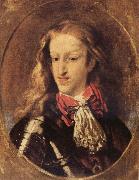Wholesale Oil Painting No Minimum |
|||||||||||
|
|
|||||||||||

|
|||||||||||
|
|
|
||||||||
COELLO, ClaudioSpanish Baroque Era Painter, 1642-1693 Spanish painter and draughtsman. Together with the court painters Francisco Rizi, Juan Carre?o de Miranda and Francisco de Herrera, he was one of the foremost exponents of a style of Spanish painting that developed between c. 1660 and 1700 and was characterized by theatrical compositions and rich colours. The sources of this late Baroque style, which was distinct from that of the previous generation of Spanish Baroque artists, most of whom painted sober, realistic depictions of religious and secular life, lie in the influence exerted by Venetian Renaissance painting and by Italian and Flemish art of the period, |
||||||||
|
|
||||||||
King Charles II
King Charles II Painting ID:: 33640 |
mk86
c.1675-1680
Oil on canvas
66x56cm
Madrid,Museo del Prado
mk86 c.1675-1680 Oil on canvas 66x56cm Madrid,Museo del Prado |
|||||||
|
|
||||||||
|
anthonis van dyck Flemish painter and draughtsman, active also in Italy and England. He was the leading Flemish painter after Rubens in the first half of the 17th century and in the 18th century was often considered no less than his match. A number of van Dyck's studies in oil of characterful heads were included in Rubens's estate inventory in 1640, where they were distinguished neither in quality nor in purpose from those stocked by the older master. Although frustrated as a designer of tapestry and, with an almost solitary exception, as a deviser of palatial decoration, van Dyck succeeded brilliantly as an etcher. He was also skilled at organizing reproductive engravers in Antwerp to publish his works, in particular The Iconography (c. 1632-44), comprising scores of contemporary etched and engraved portraits, eventually numbering 100, by which election he revived the Renaissance tradition of promoting images of uomini illustri. His fame as a portrait painter in the cities of the southern Netherlands, as well as in London, Genoa, Rome and Palermo, has never been outshone; and from at least the early 18th century his full-length portraits were especially prized in Genoese, British and Flemish houses, where they were appreciated as much for their own sake as for the identities and families of the sitters. King Charles II 1638(1638) Medium Oil on canvas Dimensions 150.5 x 130.7 cm (59.3 x 51.5 in) cyf |
||||||||
|
|
||||||||
|
Prev Next
|
||||||||
|
|
||||||||
|
Related Paintings to anthonis van dyck :. |
||||||||
|
|
||||||||
|
CONTACT US |

